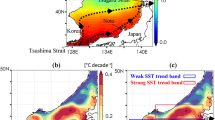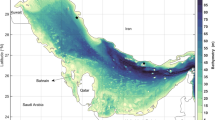Abstract
Fifteen years of merged altimetric data were used to acquire the seasonal to interanual variations of eddy kinetic energy (EKE) in the South China Sea (SCS). The results show that climatological mean EKE in the SCS ranges from 50 cm2/s2 to 1,400 cm2/s2, with high values in the regions southeast of Vietnam and southwest of Taiwan Island. The amplitude of the annual harmonic of the EKE is characterized by high values to the southeast of Vietnam where the maximum exceeds 800 cm2/s2. The EKE in the northern SCS reaches its maximum in August-February, while it peaks in September–December in the southern SCS. Besides the seasonal variation, the EKE also shows strong interannual variation, which has a negative (positive) anomaly in boreal winter during El Niño (La Niña) events. The interannual variation of local wind stress curl associated with El Niño-Southern Oscillation events may be the cause of the interannual variation of the EKE in the SCS.
Similar content being viewed by others
References
An, S. I. and B. Wang (2001): Mechanisms of locking of the El Niño and La Niña mature phases to boreal winter. J. Climate, 14, 2164–2176.
Ashok, K., S. K. Behera, S. A. Rao, H. Weng and T. Yamagata (2007): El Niño Modoki and its possible teleconnection. J. Geophys. Res., 112, C11007, doi:10.1029/2006JC003798.
Bretherton, C. S., M. Widmann, V. P. Dymnikov, J. M. Wallace and I. Bladé (1999): The effective number of spatial degrees of freedom of a time-varying field. J. Climate, 12, 1990–2009.
Chang, C.-W. J., H.-H. Hsu, C.-R. Wu and W.-J. Sheu (2008): Interannual mode of sea level in the South China Sea and the roles of El Niño and El Niño Modoki. Geophys. Res. Lett., 35, L03601, doi:10.1029/2007GL032562.
Cheng, X. H. and Y. Q. Qi (2007): Trends of sea level variations in the South China Sea from merged altimetry data. Glob. Planet. Change, 57, 371–382.
Cheng, X. H., Y. Q. Qi and W. Q. Wang (2005): Seasonal and interannual variabilities of mesoscale eddies in the South China Sea. J. Trop. Oceanogr., 24(4), 51–59 (in Chinese with English abstract).
Chervin, R. M. and S. H. Schneider (1976): On determining the statistical significance of climate experiments with general circulation models. J. Atmos. Sci., 33, 405–412.
Dorandeu, J. and P. Y. Le Traon (1999): Effects of global mean pressure variations on sea level changes from TOPEX/POSEIDON. J. Atmos. Oceanic Technol., 16, 1279–1283.
Du, Y., S.-P. Xie, K. Hu and G. Huang (2009): Role of air-sea interaction in the long persistence of El Niño-induced north Indian Ocean warming. J. Climate, 22, 2023–2038.
Ducet, N., P. Y. Le Traon and G. Reverdin (2000): Global high-resolution mapping of ocean circulation from TOPEX/Poseidon and ERS-1 and -2. J. Geophys. Res., 105(C8), 19,477–19,498.
Fang, G., H. Chen, Z. Wei, Y. Wang, X. Wang and C. Li (2006): Trends and interannual variability of the South China Sea surface winds, surface height, and surface temperature in the recent decade. J. Geophys. Res., 111, C11S16, doi:10.1029/2005JC003276.
He, Z. G., D. X. Wang and J. Y. Hu (2002): Features of eddy kinetic energy and variations of upper circulation in the South China Sea. Acta Oceanol. Sinica, 21(2), 305–314.
Ho, C.-R., Q. Zheng, Y. S. Soong, N.-J. Kuo and J.-H. Hu (2000): Seasonal variability of sea surface height in the South China Sea observed with TOPEX/Poseidon altimeter data. J. Geophys. Res., 105(C6), 13,981–13,990.
Hu, J. Y., H. Kawamura, H. S. Hong and Y. Q. Qi (2000): A review on the currents in the South China Sea: seasonal circulation, South China Sea Warm Current and Kuroshio intrusion. J. Oceanogr., 56, 607–624.
Hwang, C. and S. A. Chen (2000): Circulations and eddies over the South China Sea derived from TOPEX/Poseidon altimetry. J. Geophys. Res., 105(10), 23,943–23,965.
Kalnay, E., M. Kanamitsu, R. Kistler, W. Collins, D. Deaven, L. Gandin, M. Iredell, S. Saha, G. White, J. Woollen, Y. Zhu, A. Leetmaa, R. Reynolds, M. Chelliah, W. Ebisuzaki, W. Higgins, J. Janowiak, K. Mo, C. Ropelewski, J. Wang, R. Jenne and D. Joseph (1996): The NCEP/NCAR 40-year reanalysis project. Bull. Amer. Meteor. Soc., 77, 437–471.
Le Traon, P. Y. and G. Dibarboure (1999): Mesoscale mapping capabilities of multiple-satellite altimeter missions. J. Atmos. Oceanic Technol., 16, 1208–1223.
Le Traon, P. Y. and F. Ogor (1998): ERS-1/2 orbit improvement using TOPEX/POSEIDON: the 2 cm challenge. J. Geophys. Res., 103, 8045–8057.
Le Traon, P. Y., F. Nadal and N. Ducet (1998): An improved mapping method of multisatellite altimeter data. J. Atmos. Oceanic Technol., 15, 522–534.
Li, L., W. Nowlin and J. Su (1998): Anticyclonic rings from the Kuroshio in the South China Sea. Deep-Sea Res. Part I, 45, 1469–1482.
Liu, Q. Y., H. J. Yang and Z. Y. Liu (2001): Seasonal features of the sverdrup circulation in the South China Sea. Prog. Nat. Sci., 11(3), 202–206.
Liu, Q. Y., X. Jiang, S. P. Xie and W. T. Liu (2004): A gap in the Indo-Pacific warm pool over the South China Sea in boreal winter: Seasonal development and interannual variability. J. Geophys. Res., 109, C07012, doi:10.1029/2003JC002179.
Morton, B. and G. Blackmore (2001): South China Sea. Mar. Pollut. Bull., 42(12), 1236–1263.
Pascual, A., Y. Faugère, G. Larnicol and P. Y. Le Traon (2005): Improved description of the ocean mesoscale variability by combining four satellite altimeters. Geophys. Res. Lett., 33, L02611, doi:10.1029/2005GL024633.
Pedlosky, J. (1987): Geophysical Fluid Dynamics. Springer, Berlin, 624 pp.
Qu, T. (2000): Upper-layer circulation in the South China Sea. J. Phys. Oceanogr., 30, 1450–1460.
Qu, T., K. Y. Kim, M. Yaremchuk, T. Tozuka, A. Ishida and T. Yamagata (2004): Can Luzon Strait transport play a role in conveying the impact of ENSO to the South China Sea? J. Climate, 17, 3644–3657.
Shaw, P.-T. and S.-Y. Chao (1994): Surface circulation in the South China Sea. Deep-Sea Res. Part I, 41, 1663–1683
Stammer, D. and C. Wunsch (1999): Temporal changes in eddy energy of the oceans. Deep-Sea Res., 46, 77–108.
Stammer, D., C. Böning and C. Dieterich (2001): The role of variable wind forcing in generating eddy energy in the North Atlantic. Prog. Oceanogr., 48, 289–311.
Torrence, C. and G. P. Compo (1998): A practical guide to wavelet analysis. Bull. Amer. Meteor. Soc., 79(1), 61–78.
Trenberth, K. E. (1984): Signal versus noise in the Southern Oscillation. Mon. Wea. Rev., 112, 326–332.
Trenberth, K. E. and D. J. Shea (1987): On the evolution of the Southern Oscillation. Mon. Wea. Rev., 115, 3078–3096.
Wang, B., R. Wu and X. Fu (2000): Pacific-East Asian teleconnection: How does ENSO affect East Asian climate? J. Climate, 13, 1517–1536.
Wang, D. X., Y. Liu, Y. Q. Qi and P. Shi (2001): Seasonal variability of thermal fronts in the northern South China Sea from satellite data. Geophys. Res. Lett., 28(20), 3963–3966.
Wang, G. H., J. L. Su and P. C. Chu (2003): Mesoscale eddies in the South China Sea observed with altimeter data. Geophys. Res. Lett., 30(21), 2121, doi:10.1029/2003GL018532.
Wang, G. H., D. K. Chen and J. L. Su (2006): Generation and life cycle of the dipole in the South China Sea summer circulation. J. Geophys. Res., 111, C06002, doi:10.1029/2005JC003314.
Wang, L. P., C. J. Koblinsky and S. Howden (2000): Mesoscale variability in the South China Sea from the TOPEX/Poseidon altimetry data. Deep-Sea Res. Part I, 47, 681–708.
Wang, Y., G. Fang, Z. Wei and H. Chen (2006): Interannual variation of the South China Sea circulation and its relation to El Niño, as seen from a variable grid global ocean model. J. Geophys. Res., 111, C11S14, doi:10.1029/2005JC003269.
Wu, C. R., P. T. Shaw and S. Chao (1999): Assimilating altimetry data into a South China Sea model. J. Geophys. Res., 104, 29,987–30,005.
Wu, J. (1982): Wind-stress coefficients over sea surface from breeze to hurricane. J. Geophys. Res., 87(12), 9704–9706.
Xie, S. P., Q. Xie, D. X. Wang and W. T. Liu (2003): Summer upwelling in the South China Sea and its role in regional climate variations. J. Geophys. Res., 108(C8), 3261, doi:10.1029/2003JC001867.
Xie, S. P., C. H. Chang, Q. Xie and D. Wang (2007): Intraseasonal variability in the summer South China Sea: Wind jet, cold filament, and recirculations. J. Geophys. Res., 112, C10008, doi:10.1029/2007JC004238.
Yuan, D., W. Han and D. Hu (2007): Anti-cyclonic eddies northwest of Luzon in summer-fall observed by satellite altimeters. Geophys. Res. Lett., 34, L13610, doi:10.1029/2007GL029401.
Author information
Authors and Affiliations
Corresponding author
Rights and permissions
About this article
Cite this article
Cheng, X., Qi, Y. Variations of eddy kinetic energy in the South China Sea. J Oceanogr 66, 85–94 (2010). https://doi.org/10.1007/s10872-010-0007-y
Received:
Revised:
Accepted:
Published:
Issue Date:
DOI: https://doi.org/10.1007/s10872-010-0007-y




